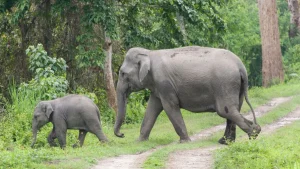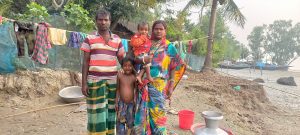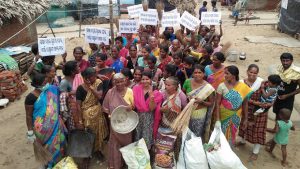Despite growing climate risk, livestock insurance is out of women farmers’ reach
Government policies oblivious to gender and caste inequities leave women livestock farmers from lowered communities without economic safety nets.
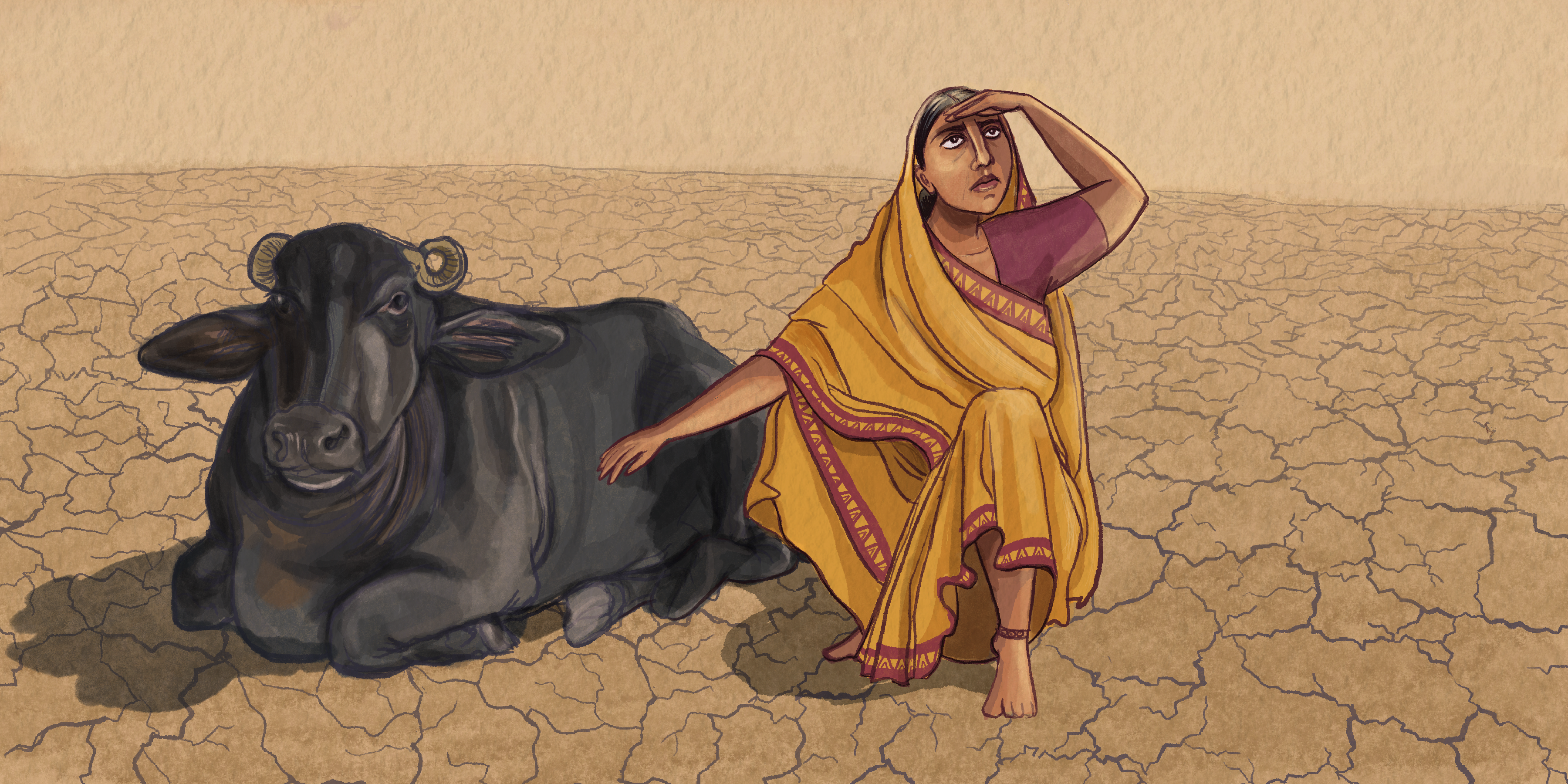
“Rs 60 for a goat! How will I afford it? I am living on loans at the moment,” Nirmala Lachhman Tubache exclaimed. Tubache is a 50-year-old woman of slight frame. She lives in Shivanoor village in Belagavi district in north Karnataka where she works as a landless labourer and rears goats. She was reacting to the cost of insuring her livestock under a government scheme.
Tubache has six goats, which she will sell for their meat when she needs additional income. Under the government scheme, she will have to pay an annual premium of Rs 60 per goat for a three-year period. That would mean a payout of Rs 180 per goat, which is half her day’s earnings working on other people’s farms. She would have to pay an unaffordable Rs 1,080 to insure all six goats.
I met Tubache one day in mid May. Her usual work doing agricultural labour had dried up along with much else in the summer months of March, April and May. “I don’t earn anything during these three months,” she said. She gets by on loans and the income from livestock. “They are my property,” she said, pointing to her goats. We were all standing in the scorching sun, as the mercury touched 43 degrees and the earth radiated sweltering heat.
Tubache took me to her neighbour’s house. While she was figuring out how to switch on a table fan, she said that her house was small and not worthy of visitors from the city. Thirty years ago, she separated from her husband who is now deceased. “He used to drink and beat me,” she said. Tubache is from the Mahar community, a historically oppressed caste group against whom social discrimination has led to economic detriment.
For her food staples, Tubache has to rely on the state government guarantee to poor households of 30 kgs of rice at the subsidised price of Re 1 per kg. Apart from farm work and selling her goats, she depends on loans to meet expenses. She once bought a buffalo with a Rs 40,000 loan but she had to sell it because she could not get enough fodder. She managed to pay back Rs 30,000. She learnt then that goats were easier to raise in dry weather. Five years ago, she took another loan to buy two goats for Rs 5,000 each. She paid that second loan back and now she has six goats. “Goats give birth to two kids every six months. I will be able to sell four of these at Rs 10,000 each,” she announced, her eyes shining for a moment at the prospect of clearing her debt. Her goats are also her failsafe in contingencies. “I educated my daughter, and took care of her wedding and the delivery of her first child by selling goats,” she said.
She will have to take out more loans if anything should happen to her goats. And the risks to her livestock and all farm animals in the area are only growing.
North Karnataka is geographically drought-prone and has been historically drought-affected. In 2018, Belagavi was declared an eternally drought-prone district along with much of north Karnataka. Climate change projections suggest further warming in the region coupled with erratic rain patterns. It can result in water and fodder scarcities, which can make livestock more susceptible to heat stress and disease.
Like in many other agricultural parts of India, small and marginal farmers and farm labourers in north Karnataka rely on livestock for the security of some assured income. A large section of livestock owners are women with close to seventy five million women as against fifteen million men engaged in dairy farming in India and 71% of the livestock workforce, according to official estimates. Women perform most dairy and livestock activities, such as feeding animals, cleaning their sheds, watering troughs, milking them, disposing of dung, and taking care of sick, pregnant and newborn or young animals. Yet, women are hardly visible in government programmes which do not recognise the need for gender-differentiated policies.
Insurance is an obvious way to protect livestock owners against losses. But the lack of agency, technology, money and land affect women farmers’ access to insurance policies. A gender-agnostic policy environment renders them without any safety net in events of animal deaths induced by climate disasters, extreme weather events and epidemics.
Escalating drought and greater distress
Shivanoor village is in Athani taluk, the northernmost subdivision of Belagavi district. With 115 villages, Athani is also the largest taluk in the district. The annual average rainfall in Athani taluk is 687 mm, almost half of the average normal rainfall in the state. Athani lies in the rain-shadow area created by Western Ghats that block the southwest monsoon. The land in the northern part of Athani is flat and does not receive any flow irrigation from the Krishna River that waters the southern part of the taluk. “North of Athani is a drought-affected area and the south receives good amounts of rain,” said Chidanand Dhavaleshwar, an assistant professor of social work at the Rani Channamma University in Belagavi and a native of Athani. Dhavaleshwar has observed weather patterns in Athani closely for two decades.
The Indian Metrological Department has recorded 53 years of drought of various intensity in Athani out of 101 years going back from 1971. Athani has had sparse rains in the last two decades. With a frequency of drought at once in four years in Athani, the Central Ground Water Board marked the taluka as drought prone in 2016-17. In 2018, it was included in the areas of the state declared perpetually drought-prone. In March 2020, the Central Ground Water Board categorised Athani’s as critical, which means that between 90% and 100% of its ground water had been extracted.
Most farmers in Shivanoor village have experienced crop failure due to drought, according to Kalgowda Gumtaj, an arts teacher in the village school who also farms about 2.5 hectares of land in the village. In 2007, the Central Ground Water Board noted 34 cases of farmer suicides in Belagavi due to catastrophic drought-induced crop failure between 2003 and 2006. Eight of these cases were from Athani. Climate change has added to Athani and Karnataka’s vulnerability. The state has the second largest rainfed area in the country after Rajasthan. Seventy nine percent of its total arable area is drought prone. With changing water cycles and rising temperatures due to climate change, scarce water resources have come under further strain.
The Karnataka Water Policy of 2022 notes that climate change studies for the state have predicted a trend of long-term warming coupled with decreased rainfall and an increase in area under drought. It further highlights that an increase in drought incidences between 10% and 80% is projected for its northern districts. Some districts may even witness a doubling of drought frequency. According to the State Climate Action Plan 2021, the northern districts including Belagavi can experience an increase in summer maximum temperature of up to two degrees Celsius by 2030 and up to 2.5 degree Celsius by 2080. Studies have shown that aridity of drylands increases with rising temperatures and rainfall variability resulting in decline in soil quality, scarce water availability and more frequent pest and disease infestations. This will directly impact the crop yield, fodder availability, livestock health and quantity and quality of milk produced by cattle.
Belagavi is the largest sugarcane producing district of Karnataka with Athani as a major contributor. However, this water-guzzling crop fares poorly in the drought conditions of the summer months. In past drought years, the area under sugarcane cultivation shrank for lack of water. In fact, in the severe drought of 2018, many people in Shivanoor village crossed the state border to work on the irrigated farms in Maharashtra. “I used to travel 25 km up and down every day to work on the farms in Salagare village [in Maharshtra’s Sangli district],” Tubache said. “I would get Rs 200 for half a day’s work.”
About 300 metres away from Tubache’s house, Sangeeta Mahadev Katkar had a small window of time to rest after tending to her family farm, her buffalo and a calf and her household chores. Katkar is from the Maratha community, which is classified as an Other Backward Class in Karnataka. Her husband owns a little over a hectare of farmland on which they grow jowar, bajra, wheat, gram and sugarcane. She feeds the crop waste to the buffalo. Farmers in the region buy fodder if they cannot produce enough crop waste from jowar, sugarcane and maize to feed cattle. They also feed them oil cakes for better milk production. They told me that they pay Rs 25 for two kgs of hay, Rs 1,200 for a 50 kgs bag of wheat straw, and Rs 45 per kg of oil cakes. In 2018, Katkar had to sell her Jersey cow. “It was a drought year, we could not get fodder. One or two kg of sugarcane is not enough,” she explained. An adult Jersey cow needs between 20 kg and 25 kg of fodder every day.
In 1974, with assistance from the World Bank, the Karnataka government initiated a dairy development project following the model of the highly successful Amul cooperative system in Gujarat. By 1984, with the onset of integrated dairy development that created a milk grid linking producers across India with consumers from cities, dairy farming emerged as a plausible alternative to crop cultivation in arid parts of Karnataka, including Athani. The state is home to the largest number of dairy cooperatives. As of July 2020, Karmataka had 14,682 dairy cooperatives with 25 lakh milk producer members. Various state governments over time have promoted milk production in dry areas through the Karnataka Milk Federation, the apex body for the dairy cooperative movement, as an adaptation strategy to drought. “Our cooperatives ensure income for small and marginal land owners and women farmers, especially those experiencing drought,” said an extension officer of the federation, who did not want to be named.
Aside from cattle, rearing small ruminants like goats that can be sold for meat ensure income and food security for small and marginal farmers and the landless in arid and semi-arid rain-fed areas. But risks such as scarcity of fodder, water and high morbidity due to extreme weather events such as heat waves and floods or in case of an epidemic make owners of cattle and small ruminants highly vulnerable.
Livestock insurance
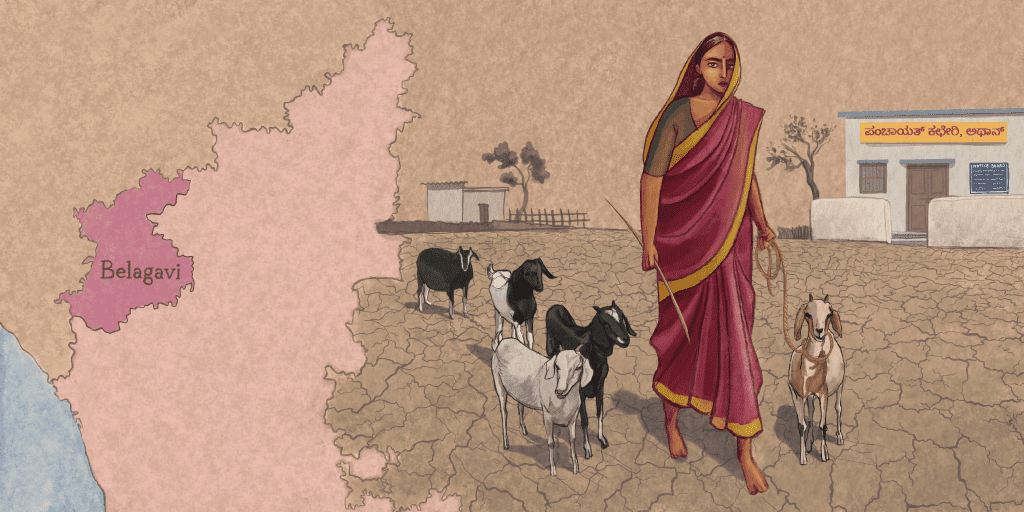
In the age of climate change, insurance is a recognised means of resilience. It is the parachute that provides a soft landing to low-income households that are plunged into economic distress by weather extremes and natural disasters. Acknowledging its role in income diversification, the central government piloted a livestock insurance scheme in 2005 in 100 selected districts across the country. Belagavi was added to the pilot programme between 2008 and 2012 when the government noted the prevalence of farmer suicides in the district. In 2014, the scheme was refurbished with lessons from the pilot and made part of the National Livestock Mission to be implemented nationally.
Under the insurance component of the National Livestock Mission (NLM), the government provides a 50% subsidy on annual premiums for livestock insurance. This applies to five animals (except for sheep, goat, pig and rabbit) per household. A household can avail of the subsidy for up to 50 small ruminants, such as sheep and goats, pigs and rabbits. For beneficiaries from Scheduled Castes and Tribes, the central and state governments together shoulder 70% of the insurance premium. To apply for insurance, the animal owner needs to provide a health certificate providing details such as age, identification marks, health status and market value of the animal. Once the owner asks for insurance, the veterinary doctor goes to the house of the beneficiary and fills the application with all details. Vets, therefore, double up as livestock insurance officers and are the foot soldiers on which the scheme is dependent.
Neither Tubache or Katkar have insurance for their animals. Katkar said she knew about the scheme. “The doctor who came to inseminate the buffalo told me about it,” she said. “When I asked how to get the insurance, he said he did not have time to explain.” Karnataka has been facing shortage of veterinarians leaving the ones working in rural areas overburdened. High instances of lumpy skin disease have also added to their workload. Erratic rains in 2022 in the dry parts of Karnataka provided a warm and humid climate that aided the carrier insects of the lumpy skin disease virus to spread the contagious and potentially fatal disease.
The primary veterinary center in Jambagi gram panchayat, under which Shivanoor village falls, does not have a veterinary doctor. Basavaraj Biswagar, the chief veterinary officer at the animal husbandry department in Athani, told me how vets in the region were overstretched. “We work through the week with only half a day’s leave on Sundays. We try to respond to each and every call we get. But it is difficult,” he said.
The other challenge that this mode of operation poses is that most of the vets are male and so many women are discouraged from talking to them at length. “I am hesitant to talk to a man, Katkar confided. “If it was a woman then I would ask her questions. And women do not hide anything, they will spill all details anyway.”
Women only in targets
In May, the animal husbandry department had already met over 80% of its annual target of insurance cover of Rs 10 lakh for Athani. The targets for 2023-2024 were yet to be announced, according to Biswagar. But these targets are minuscule. Biswagar broke down the economics of the scheme. “The average premium rate charged by the insurance companies is 2% of the animal cost. A cow comes for Rs 50,000 and a goat for Rs 10,000. The premium comes out to be Rs 1,000 for a cow and Rs 200 for a goat. A farmer from the general category has to pay Rs 500 or Rs 100 a year and those from Scheduled Caste and Scheduled Tribe categories will pay Rs 300 or Rs 60 a year for a cow or a goat, respectively,” he explained. Therefore, Rs 10 lakh insures a maximum of 2,000 cows or 10,000 goats for a year. The livestock population in Athani ranges between 2,50,000 and 4,00,000 leaving the vast majority uninsured. This is a problem across India. Haryana, for example, allotted a budget to insure only 6,00,000 of its 70,00,000 heads of livestock in 2022-2023.
The budget allocation of 2022-23 to the central department of animal husbandry and dairying does not even mention women. The operational guidelines for the National Livestock Mission, says, “State Governments may also strive, as far as possible, to cover physically 8%, 30% and 3% Scheduled Tribe, Women and physically challenged/differently abled persons/farmers/beneficiaries, respectively.” Due to the optional nature of these targets for women in the guidelines from the centre, states too do not go beyond collecting gender disaggregated data.
Veterinary officers in Athani that I spoke to admitted that there were no special awareness initiatives for livestock insurance directed at women. Inspectors and doctors disseminate information during their occasional visits to farms when, as Katkar told me, women find communicating with them difficult. Apart from this, circulars for the scheme are pasted on notice boards of panchayat offices and uploaded on the department’s website. But these measures leave women like Tubache out. She cannot read and does not own a smartphone. Tubache cannot even afford veterinary visits for which she will have to pay about Rs 50 to cover the vet’s commute to the village.
“We need to target women consciously,” said Rupsha Banerjee, senior scientist of institutions and innovations at the International Livestock Research Institute in Nairobi, where she leads the agenda on drought risk financing focussed on the drylands, especially for marginalised communities and women including use of digital information for service delivery in Africa. Banerjee is researching policy needs for drought risk financing in India.“Efforts need to go beyond the gender-disaggregated numbers. How to word the message is important.” Banerjee said Tubache’s lack of awareness about the scheme was a weakness of official messaging. “If we start the message with pashu bima or livestock insurance, women shut down immediately because livestock is understood widely as cow and buffalo, whereas many single women depend on small animals like goats and sheep,” she explained.
Till recently, the Karnataka livestock insurance scheme only covered animals purchased using bank loans. “The scheme is directly linked with loan schemes. All animals bought using loans get automatically insured,” Biswagar said. This limits women’s participation as commercial banks often focus on men and formal businesses while granting loans. Oftentimes, the loan itself is conditional on land holdings as guarantees. An affluent farmer in Shivanoor from a privileged caste told me that he had to provide land ownership documents to insure his cow and two buffaloes.
Tubache and Katkar often rely on non-institutional loans which they take from self-help groups called sanghas. “In the last 15 years, I have taken loans 17 times and paid them off in time,” Katkar said proudly. She has never taken a loan from a bank because that involves a lot of jhanjhat or bother because of paperwork. Women in rural India largely rely on informal channels for loans. The NABARD All-India Rural Financial Inclusion Survey 2016-2017 found that more than 30% of rural households in India borrowed money from non-institutional sources due to the lengthy loan sanction processes and stipulations of collaterals.
Katkar and other women dairy farmers I spoke to prefer to provide milk to private dairies rather than the state milk cooperative so that they can pay off their loans or take care of sudden expenses. The private dairies give them advance payments which the cooperative does not, Katkar explained. “In the past year and a half, many members have moved to private dairies. In one of the Northern districts, our milk collection has come down from over two lakh liters a day to 40,000-50,000 liters a day,” the KMF extension officer confirmed.
Under the National Livestock Mission, Karnataka government has decided to delink the scheme for loans. It has also decided to engage KMF to support its cooperative members, in which 40% of the insurance premium is paid by the government, 30% by the cooperative and 30% by the cattle owner. Under its Support to Training and Employment Programme, the KMF organises women dairy cooperative societies and offers interest free loans of between Rs 20,000 to Rs 25,000 for purchase of animals. “Insurance comes with it. Yet women don’t come forward,” the extension officer said. However, a cow costs about Rs 50,000. “Private dairies offer bigger loans,” said Saraswati Sitappa Kamble, a single woman farmer who owns a cow. “They also let me keep Rs 500 weekly from the milk sale.”
KMF also has another scheme called Pashu Bhagya which provides subsidies of between 35% to 50% to small, marginal farmers and farmers from scheduled caste and tribes to buy animals with loans of up to Rs 1.2 lakh from commercial banks. The animals thus purchased are insured automatically. The subsidy is adjusted at the back-end of the payment cycle which means that the farmer has to make the initial repayments themselves. The tedious application and document submission process and the repaying the initial tranches without any support keeps women out.
High premiums and digital divides
To claim insurance under the national scheme when an animal dies, a farmer is expected to provide a GPS-tagged photo of the animal or have a video call with a veterinary doctor. “We have simplified the procedure,” Pavan Kumar Doddi, the Belagavi branch manager at New India Insurance, said. New India Insurance is one of the companies providing insurance through the government scheme in the district. “Everything happens with the mediation of the veterinary doctor. Earlier we used to send an investigation officer, but not anymore.”
Although the number of mobile phones in rural India has increased significantly, women’s access to smartphones, internet and computers is still quite low. Their mobile phone use is often shared with men of the family and is timed and surveilled. “We need to differentiate between smart phone access and use,” said Banerjee. “Smartphones are usually shared within a family in rural India and Africa. We need to see if and when a woman actually gets to access a phone. Also, can she actually use it?” Katkar said she was unable to use her son’s smartphone. “He locks it, I don’t know how to unlock it,” she said.
The premium cost under the national scheme is also a barrier. For women-led households, small and marginal farmers and agricultural labourers who have one or two animals, amounts between Rs 200 and Rs 500 are prohibitively high. “It has not rained as yet and the farmers do not have money,” the officer at Jambagi veterinary center, who did not want to be named, told me that week in May. “They think ‘Why buy the insurance when we may sell the animal in two-three months?’” A veterinary doctor from the taluk said that they encourage farmers to buy three-year policies to avoid the hassle of annual renewal procedures. This increased the premium payout three-fold, which meant that a farmer like Tubache would have to pay Rs 180 per goat at one go even after the 70% subsidy for members of scheduled castes. She simply could not afford it.
In April this year, the Parliamentary Standing Committee noted that states had insured less than one percent of livestock in the country in 2021-2022 under the National Livestock Mission. It also expressed displeasure that the animal husbandry department failed to provide a status of fund utilisation for 2022-2023. After being chided by the committee, the government has been considering an overhaul of the scheme. “For women, specific tying up of services is required,” Banerjee advised. “Linking the insurance scheme with a savings account or loan or something else needs to be decided carefully.” She recommended an insurance product based on weather index and delinked from animal death in which a payout is given to the scheme holder as soon as an area is declared drought-affected. “It will ensure water, fodder and treatment for the animal and income-security for the household,” she said. However, declaration of drought itself has been mired in centre-state contestations creating bottlenecks in relief disbursal.
In Karnataka, a new lift irrigation scheme promises to bring water from the left bank of the Krishna river to many areas in the north including Athani. The Central Ground Water Board has built several water harvesting structures enhancing ground water levels. Residents of border villages in Maharashtra and Karnataka have been reviving the Agrani river, a tributary of the Krishna. “Now there is no water problem. We have borewells. At 300 feet we get water,” a stocky man in his thirties interjected while I was speaking to Katkar. But for all these developments and no “severe” drought being declared in half a decade, many farms stand fallow during summers and the landless go without work.
The day I was in Athani, Lakshman Savadi, a former deputy chief minister of the state, won the Athani assembly seat by a huge majority. Savadi is known to support the completion of pending irrigation projects. “In five years, this place is going to be transformed. Savadi is the Irrigation Man,” Dhavaleshwar declared. But Katkar knows that for people like her at the bottom of the agricultural chain, it all comes down to the rains. “If there is rain, there is cash,” she said, as she looked up to the sky from her courtyard where her buffalo was tethered.
[ Illustrations by Manimanjari Sengupta(she/they). Manimanjari is a painter and illustrator with a background in Sociology and Law. Their work is rooted in challenging the status quo laid down by patriarchy and highlighting lived experiences of women and non-binary folk.]
[This story is supported by Meedan’s Independent Media Response Fund granted to Climatera, a journalism venture focused on reporting on the climate emergency in India.]
Our Newsletter
Subscribe to Our Newsletter
We believe everyone deserves equal access to accurate news. Support from our readers enables us to keep our journalism open and free for everyone, all over the world.
